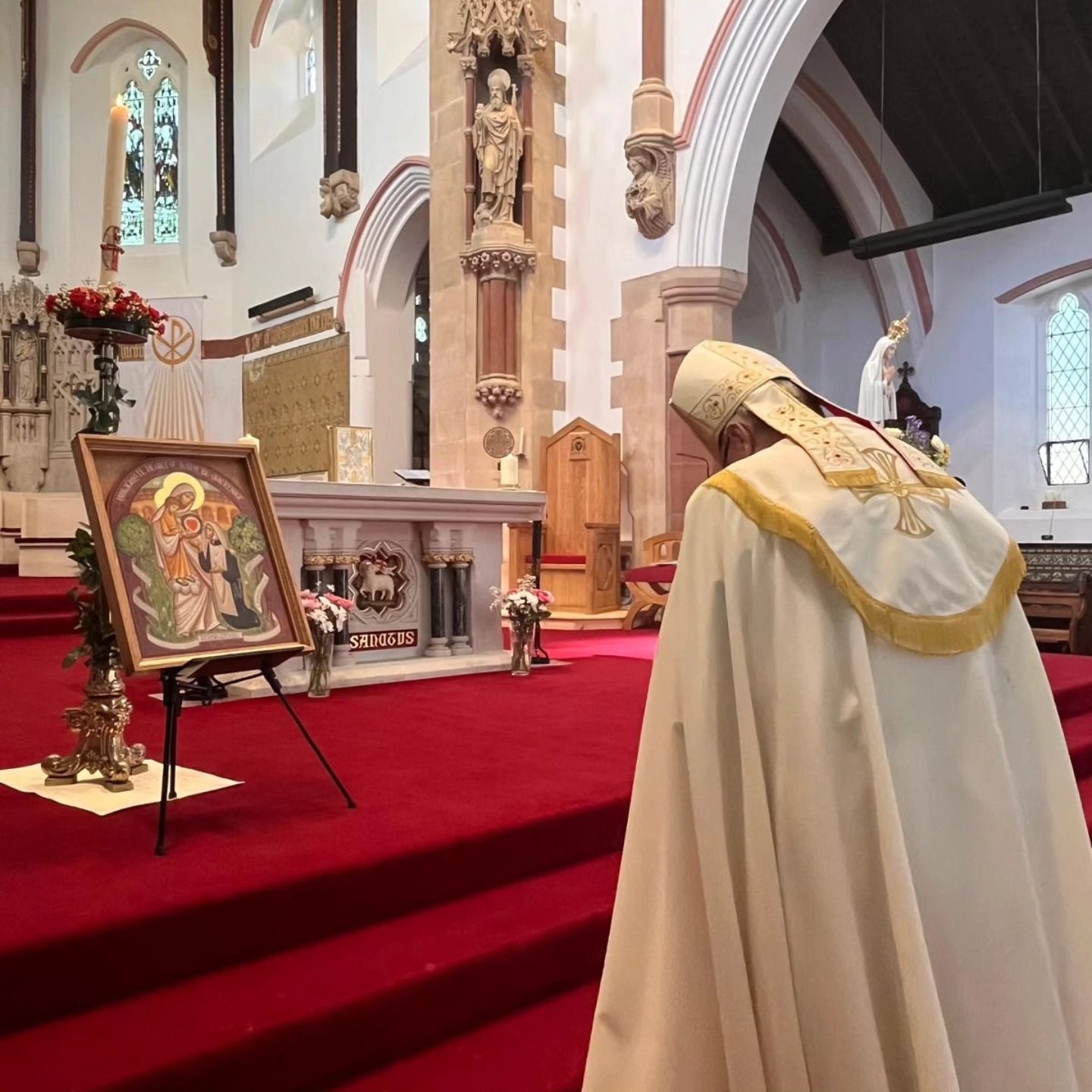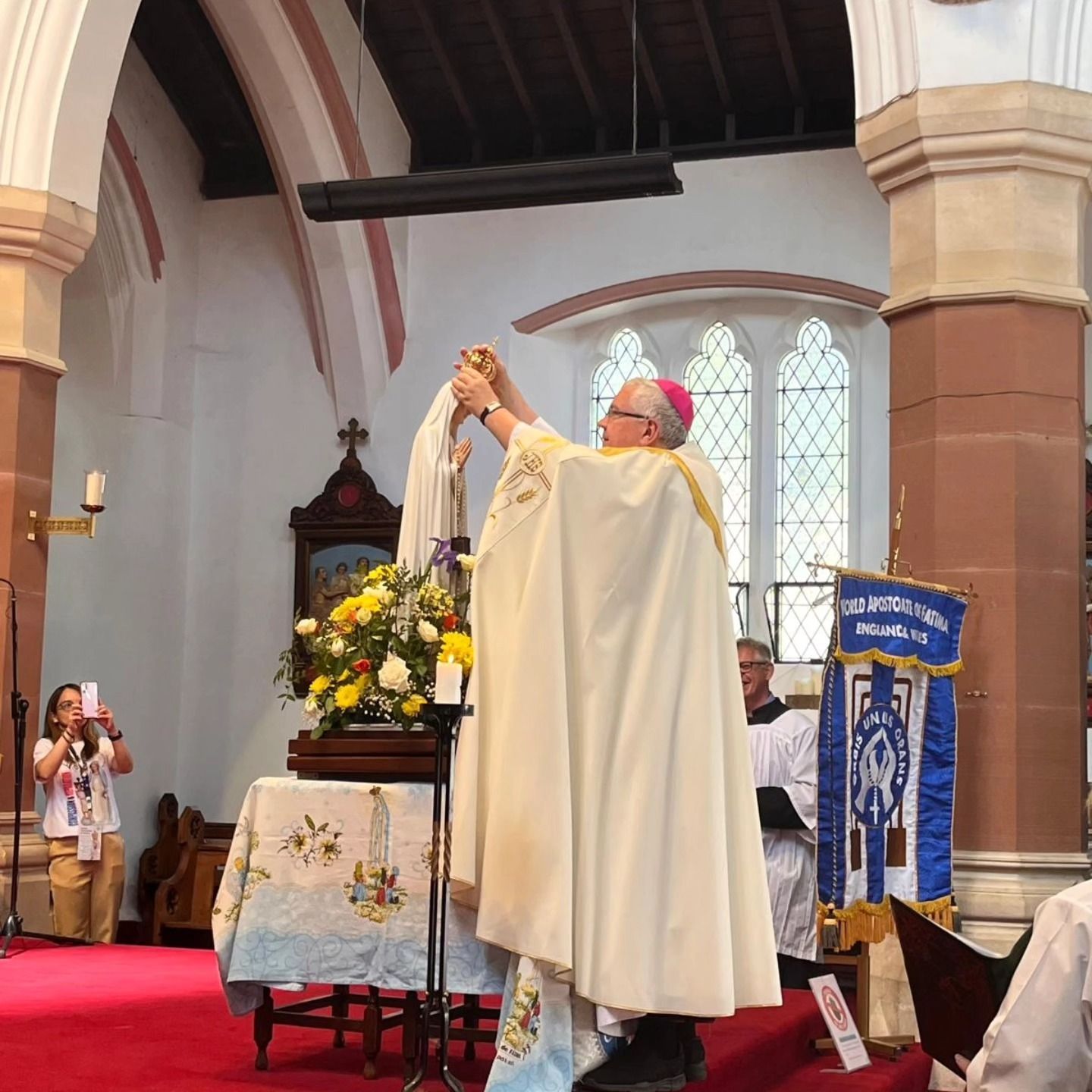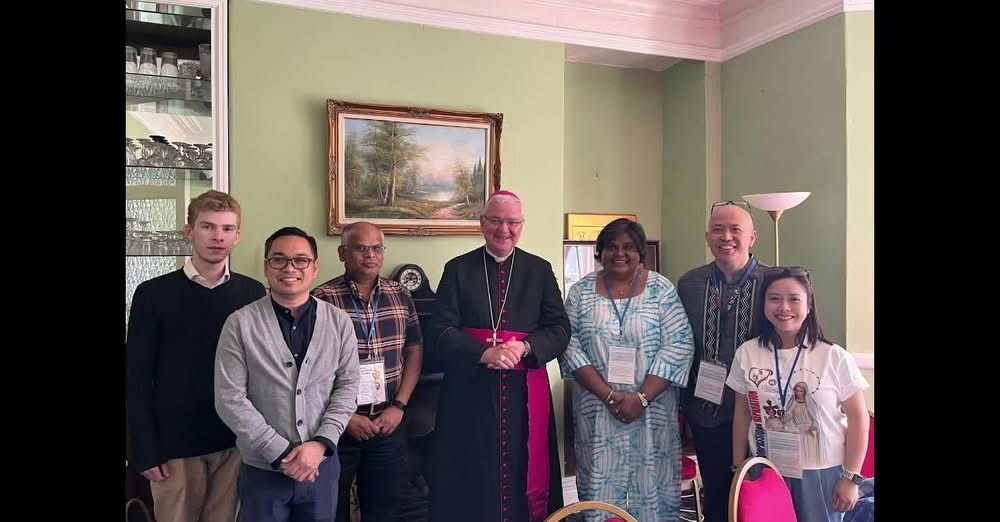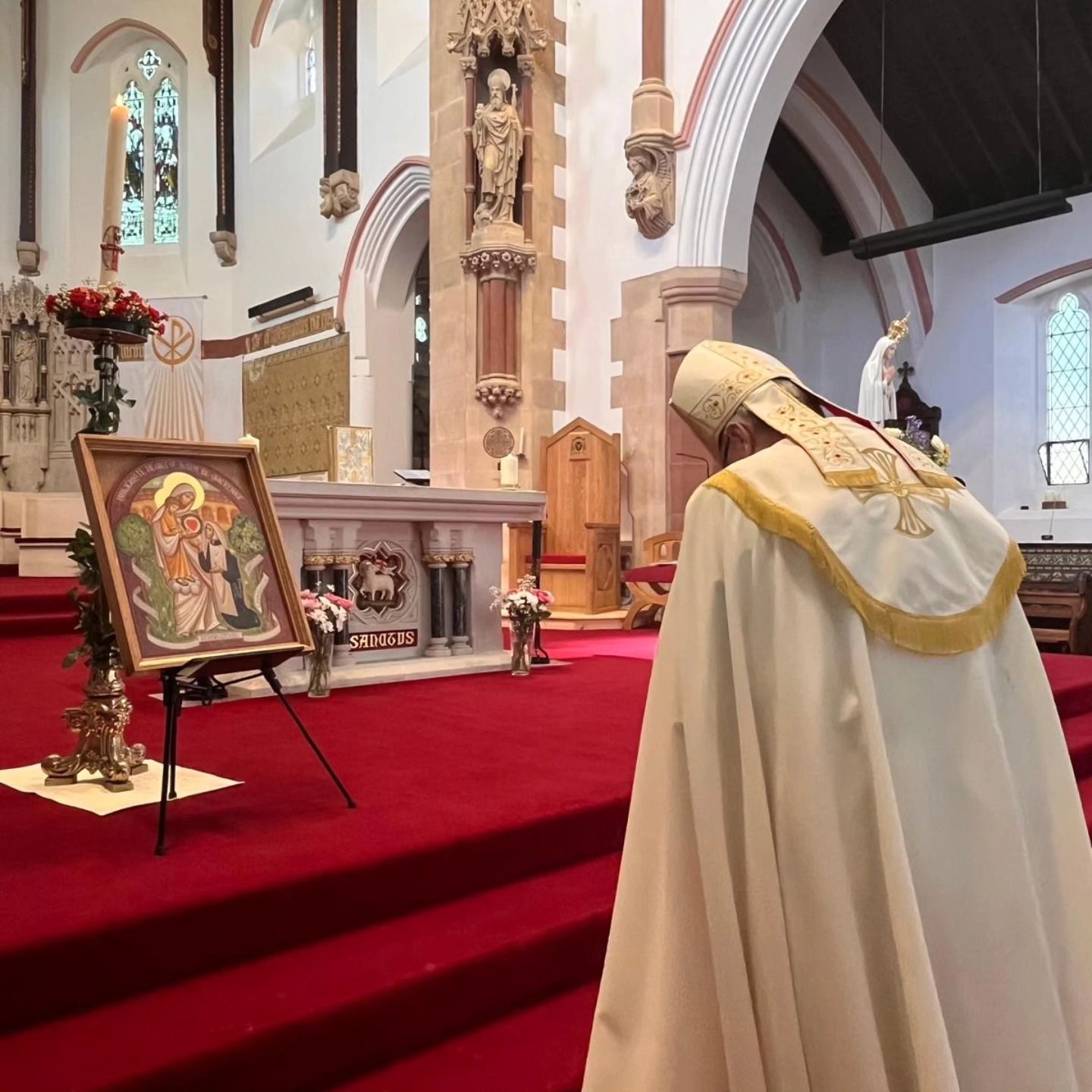Devotion of Reparation Icon
First Five Saturdays Icon by Amanda de Pulford
The World Apostolate of Fatima, England and Wales, is thrilled to present the newly commissioned Icons aimed at promoting reparation and the First Five Saturday devotion. These remarkable icons were completed with the help of our team, with the final versions crafted by artist Amanda de Pulford.
These icons were commissioned and made to commemorate the Centenary of the request of the First Five Saturdays Devotion, and they will accompany the two Fatima Statues and Relics on their church and cathedral Visitations.
The First Five Saturdays Devotion devotion was given to us by Our Lady and the Christ Child when they appeared to Sister Lucia on 10 December 1925.
The Immaculate Heart of Mary is encased in a tangle of thorns, and is held in a circle, the outer rim of which is dark. This is a convention in iconography which indicates the unknowable uncreated light.
The circle itself is a symbol of Eternity. The apparition is set in a cloister to denote Sister Lucia’s enclosure and also her interiority.
The Child Jesus stands on a cloud; the Mother of God touches Sister Lucia as described in her Memoirs.
The five important requirements of the reparatory devotion are shown near the edges of the Icon and along the lower border: the Rosary, Meditation, Confession, Holy Communion, and Reparation.
The Greek lettering beside Our Lady is the traditional title of Mother of God, Theotokos or “God bearer.” The lettering beside the Christ Child simply means Jesus Christ. Both are abbreviated: the curly symbol over the lettering denotes an abbreviation.
Although looking towards one another with intensity and compassion, the figures are also facing towards the viewer because the apparition was not for Lucia alone but a message for the world.
We sincerely thank Amanda de Pulford, the Icon writer, and a generous benefactor, who made the creation of these beautiful and very meaningful Icons possible.
The Icons will travel with the Centenary Pilgrim Virgin statue of the Immaculate Heart in the northern dioceses and with the National Pilgrim Virgin Statue of Our Lady of Fatima in the southern dioceses.
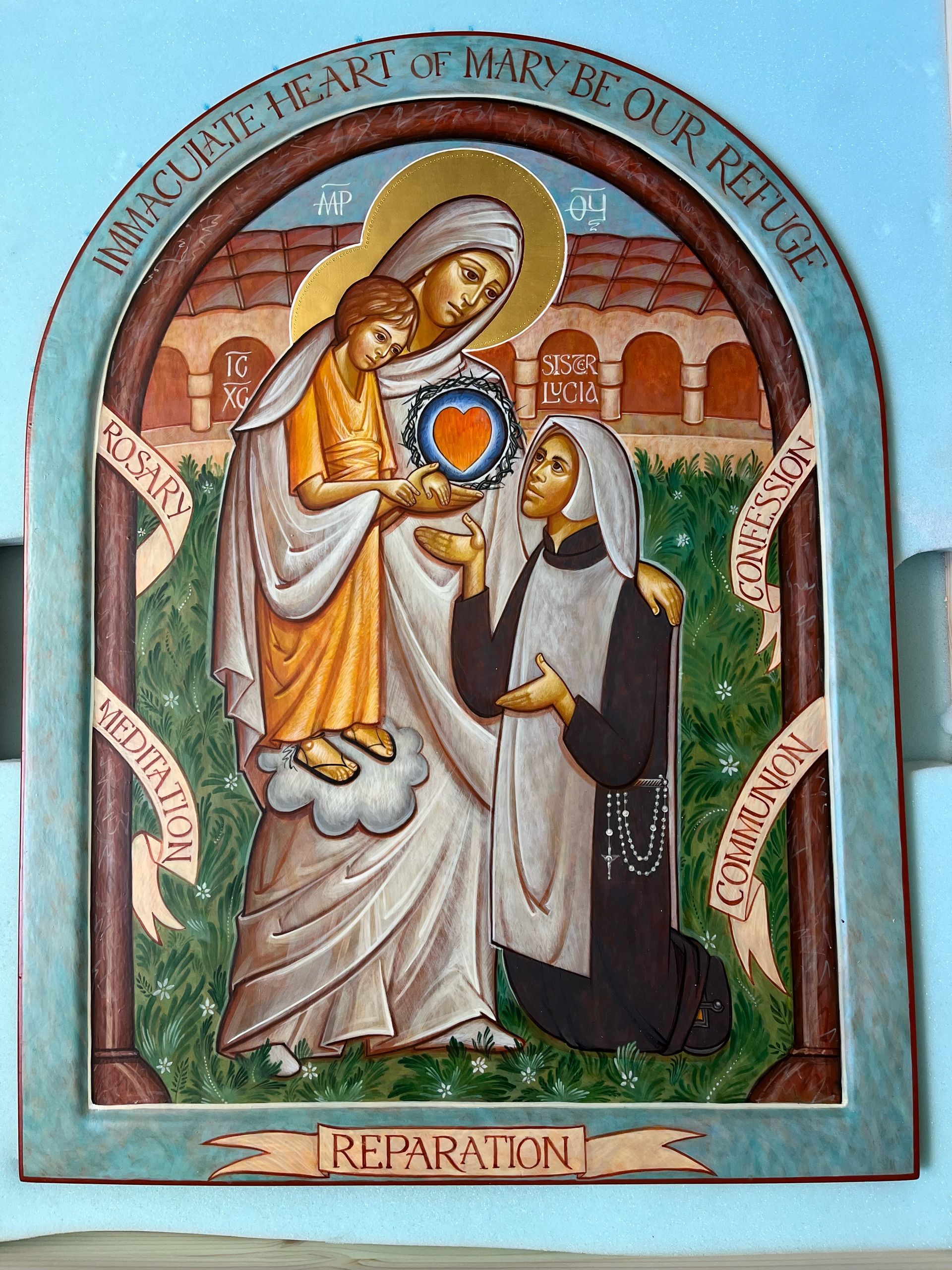
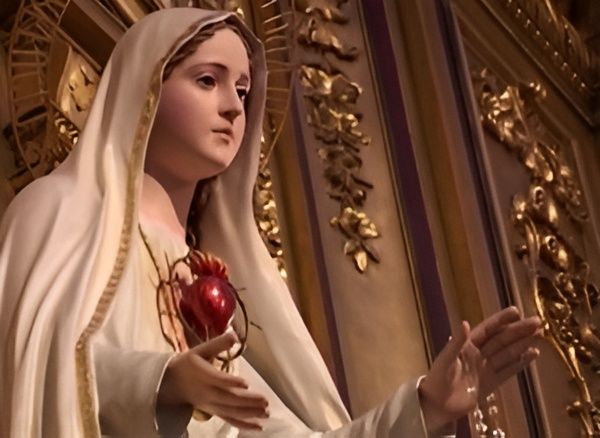
The thorns in the Icons represent the five blasphemies and offences against the Immaculate Heart of Mary:
- Blasphemies against the Immaculate Conception
- Blasphemies against Her Perpetual Virginity
- Blasphemies against Her Divine Maternity
- Blasphemies by those who instil indifference, contempt, or hatred for Mary in
the hearts of children
- Blasphemies by those who dishonour Her sacred images
Amanda de Pulford's reflections on her work
On that day, Sister Lucia tells us that the most Holy Virgin came to her accompanied by the Child Jesus standing on a luminous cloud. Placing her hand on the shoulder of Sister Lucia the Blessed Mother of God showed her heart surrounded with sharp thorns, representing the five species of blasphemy perpetrated against her Immaculate Conception, Perpetual Virginity, Divine Motherhood, her holy images and her seat in the heart of children.
The Child Jesus spoke to Sister Lucia asking her to ask the world for compassion; for the thorns to be removed from the Immaculate Heart of His holy Mother. Our Lady then described the practices that became the First Five Saturdays Devotion and promised that those who follow those practices will receive “all the graces necessary for salvation”.
In the spring of 2023, I took part in a walking pilgrimage from Coimbra to Fatima. It was a time for grappling with the difficult truths of the Fatima story. For a Catholic convert of my (liberal) generation the notion that it could be acceptable for a loving deity to ask for such sacrifice and suffering from three innocent children is hard to rationalise.
But during the course of the pilgrimage something shifted in me. I began to understand that the greed and violence of humanity can only really be seen and understood through the eyes of innocence. In the children of Fatima, it was the clear sight of innocence that saw the necessary sacrifice and willingly made it.
I was still assimilating all of this a year later when I began working on the icon. It was a complex commission. So many questions! How should the three principals be portrayed? What should they wear and how should they look? How do I make the Christ Child stand on a cloud and look natural? How to convey the essence of the First Five Saturday’s devotion?
And then, there was the problem of the Immaculate Heart itself: should it be a realistic organ, blood vessels and all? How to do it without it becoming a horror movie? Above all, how to be true to the feeling and the meaning of the event?
To begin with I looked at the images made by other artists over the years. I noticed a strange thing. In almost all of these pictures, Sister Lucia has her back to the viewer. This gave me the answer to the central question about how the three principal figures should be represented.
As I understood the event, Sister Lucia was being given the task of delivering a message to the world - but no one ever delivers a message with their back to the person to whom the message is addressed! For that reason, I drew all three figures facing outward, so that the viewer becomes part of this intimate and vital conversation.
The next problem to be solved was that of context. Where should I place this event? Should it be a mountain top? Or a dream-like cloud? After much thought and many drawings, I was looking back through my pilgrimage photos and happened to find a beautiful image of a cloister and garden: I think it was Santa Clara a Nova convent in Coimbra. It seemed an appropriate setting, knowing that Sister Lucia was a Dorothean postulant at the time of the apparition. I drew a cloister behind the three figures.
And then I remembered that the enclosed garden is a symbol for the Perpetual Virginity of OurLady. I also remembered a conversation with my eldest brother, who gave me the idea that because Our Lady was conceived immaculate, in effect we can say that she alone amongst humankind was never expelled from Eden.
The ground on which she walks is Paradise. As I worked and painted, the conviction grew, so that in the second icon I included a fig tree and an apple tree at the gates of the cloister garden, which can also be seen as the Garden of Eden.
It only remained to include the elements that constitute the First Five Saturdays devotion. At first, I considered painting small vignettes in the corners of the icon designed to show people praying the Rosary, making their confessions, meditating, and participating in the Mass.
In the end I felt that would make for a very cluttered and confusing image; one which far from giving a message would obscure it. So I chose to use a very straightforward device and simply wrotethe words on a banner.
When Brother Oliver Abasolo from the World Apostolate of Fatima England & Wales approached me to propose the making of these two new commemorative icons, I was both very honoured and very excited.
To be asked to commemorate for the first time an event of such significance in the recent history of the Church is an unusual thing in the life of an iconographer.
Because iconography is such an ancient art form (indeed, it is the art of the Church dating back to its earliest beginnings) most subjects a contemporary iconographer is called upon to produce have been painted before: there is a precedent and a pattern: a time-honoured way of representing the events of salvation history. However, there is no formal precedent for thisimage (or at least my searches for one were fruitless). It had to be invented from first principles.
As I have told the story, it sounds as though the images developed according to perfectly logical and swift progression. In truth the process was agonising and took weeks and weeks of discernment, and weeks more to draw and paint on the gesso panels.
But God is good, and that struggle was balanced by the great joy I have experienced in spending many hours of contemplation; firstly, of the accounts of the Apparition, and then as the images began to come together contemplating the beloved faces as they emerged.
It is the privilege of an iconographer to feel really present at the event that is being depicted.
I hope and pray that all those who see these icons will feel some similar measure of inclusion, joy and enrichment; and that the message of the First Five Saturdays Devotion will bring reparation, reconciliation and hope to many.
Amanda de Pulford

Slide title
Write your caption hereButton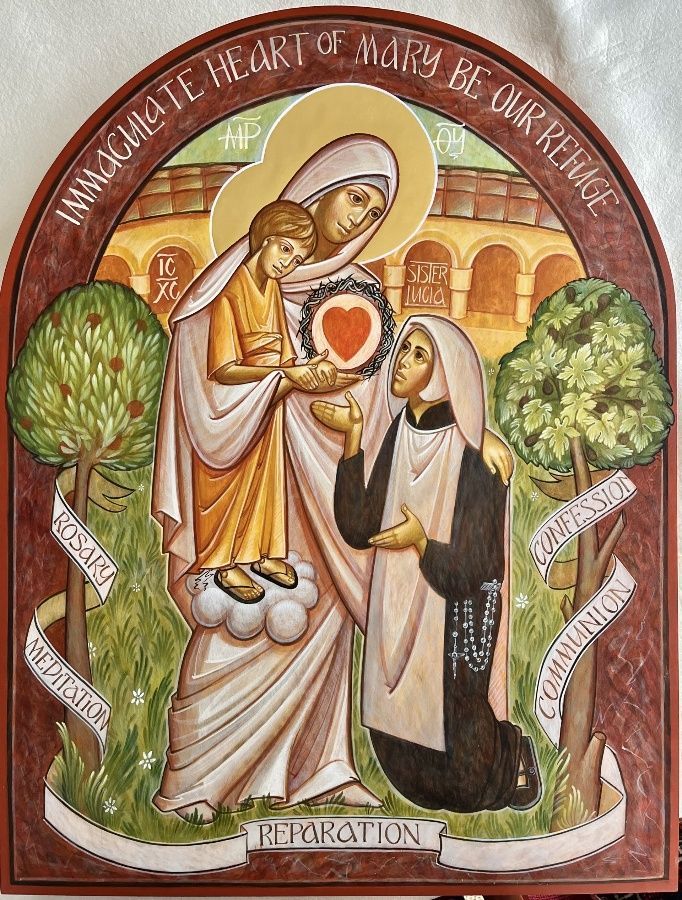
Slide title
Write your caption hereButton

